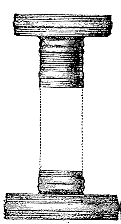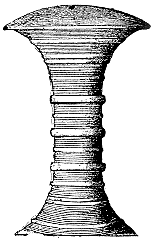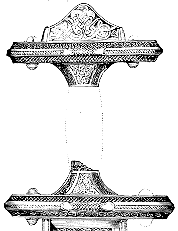

This detail photograph is of the opposite side of this sword from that shown in the full length view. All that remains of the hilt is an unornamented iron tang button which is 4.2 cm. in width and 0.7 cm. in thickness. The hilts (guards and grips) of earlier Migration Period swords were usually made of perishable organic materials such as wood, horn and bone which only rarely survive. Later hilts often employed layered organic and metal composites for the guards, with the proportions of metal ever increasing later and later in the period. An evolutionary pattern in which the tang button gains decoration and is seen to enlarge to become the pommel has been recognized (see fig. 77 on p. 137 in Menghin (1983) and many illustrations in Behmer (1939)). The tang of this blade is relatively slender and thin (0.4 cm.).
Illustration (above) of an early Migration Period sword of Behmer type V retaining its hilt, from the Nydam bog (now northern Germany). A thin layer of silver has been applied over an organic base to form the hilt. From DuChaillu (1889), figure 485.



Migration Period hilts, earlier to later, left to right: Behmer type II noted as having a thin silver covering over the hilt (Norway), Behmer type V noted as being of wood and bronze (Norway), and Behmer type VI mounted in gilt bronze and silver (Sweden). From DuChaillu (1889), figures 839, 840 and 835.